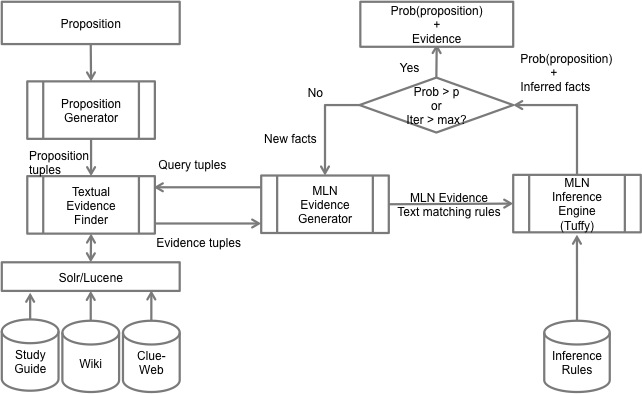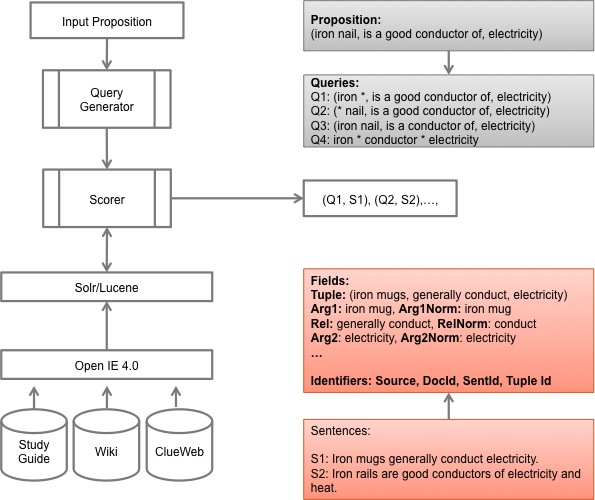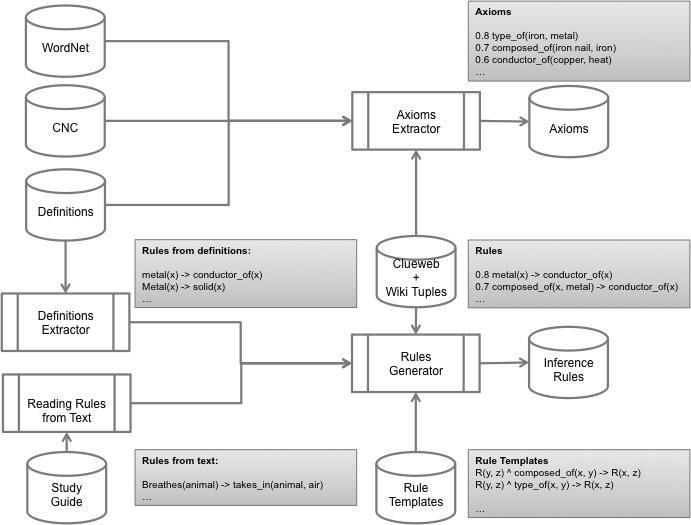Difference between revisions of "Vulcan/SystemStatus"
From Knowitall
(→Inference) |
(→Inference) |
||
| Line 34: | Line 34: | ||
5. Compute textual transforms for T. For each T': | 5. Compute textual transforms for T. For each T': | ||
-- Find evidence for T' using textual evidence finder. | -- Find evidence for T' using textual evidence finder. | ||
| − | -- Compute textual matching score for T' with N | + | -- Compute textual matching score for T' with N and add a rule Score(N, T'): N => T' |
6. Go to step 2. | 6. Go to step 2. | ||
Latest revision as of 20:29, 13 September 2013
Contents
Overview
The input to our inference system is a natural language sentence that corresponds to an answer choice. (e.g., Iron nail is a good conductor of electricity). The output is a score that represents the system's belief regarding the validity of the input sentence.
At a high-level the system performs the following steps:
- Process sentence through Open IE 4.0 and convert it into a tuple. We refer to this query tuple as a proposition.
- Find textual evidence that could support the input proposition. Find tuples and sentences that match the input proposition. Convert this textual evidence into axioms and rules in Tuffy's MLN format.
- Run Tuffy with both textual and KB evidence. Output the marginal inference scores.
The system consists of Inference (online) and Axiom and Rule generation (offline) components.
Inference
- Idea
- Iteratively perform inference on new evidence until some termination criterion is met.
- Procedure
1. Select evidence for input proposition (T) using textual evidence finder. [This procedure is a bit hazily defined at the moment.]
-- Extract CNC and hypernym predicates from arguments in proposition.
2. Run MLN inference.
3. Check Termination criterion: Terminate if probability > threshold or if iterations exceed limit.
4. For each newly inferred fact (N):
-- Compute textual matching score for N and T, and add a rule Score(N, T): N => T with the textual matching score as its weight.
-- Extract CNC and hypernym predicates from the new arguments.
5. Compute textual transforms for T. For each T':
-- Find evidence for T' using textual evidence finder.
-- Compute textual matching score for T' with N and add a rule Score(N, T'): N => T'
6. Go to step 2.
Status
Last updated Aug 23, 2013.
| Component | Description | I/O | Status | To Do |
|---|---|---|---|---|
| Proposition Extractor | Extracts propositions to be verified by the system | Input: Sentence asserting the answer choice. Output: A proposition represented as a open IE tuple. |
Stub implemented: Sentence piped into Open IE 4.0. Output tuples that fit a specified pattern are converted into a proposition. | Select the best tuple. Stem, normalize, extract polarity, handle n-ary tuples. |
| Textual Evidence Finder | Provides evidence for the input proposition using weak text-based methods. | Input: Proposition Output: Rules/Axioms that derive the proposition (in one-step) weighted according to the confidence provided by each method. |
Tuple matcher implementation underway. Uses Open IE solr instance to find matching sentences/tuples. Pattern matcher not implemented. |
Implement pattern matching, improve tuple matching, add scores. |
| MLN Instance Generator | Converts the evidence into MLN input format. | Input:Axioms/Rules from weaker methods. Output:Translated into Tuffy's input format. |
Stub implemented: Does a faithful translation to MLN syntax. | Fix bug in predicate definitions. |
| End-to-End Driver | Command line application. | Input: Sentence asserting an answer choice. Output:Score |
Stub implemented. | Create web interface. |
Textual Evidence Finder
Greg is going to be developing this component.
Axiom and Rule Generation Components
| Component | Description | I/O | Status |
|---|---|---|---|
| Axioms Extractor | Generates axioms from multiple knowledge sources. | Input: Output: |
None. |
| Rules Generator | Uses second order rule templates to generate first-order inference rules. | Input: Output: |
None. |


